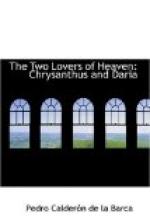or monsters that typified human passions, but did
not personify them. In the Autos it is precisely
the reverse. Rarely do actual beings take part
in the drama, and then only as personifications of
the predominant vices or passions of the individuals
whose names they bear. Thus in my own volume,
Belshazzar is not treated so much as an historical
character, but rather as the personification of the
pride and haughtiness of a voluptuous king. In
The Divine Philothea, in the same volume, there are
no actual beings whatever, except The Prince of Light
and The Prince of Darkness or The Demon. In
truth, there is nothing analogous to a Spanish Auto
in English original poetry. The nearest approach
to it, and the only one, is The Prometheus Unbound
of Shelley. There, indeed, The Earth, Ocean,
The Spirits of the Hours, The Phantasm of Jupiter,
Demogorgon, and Prometheus himself, read like the
‘Personas’ of a Spanish Auto, and the
poetry is worthy the resemblance. The Autos Sacramentales
differ also, not only in degree but in kind from every
form of Mystery or Morality produced either in England
or on the Continent. But to return to the lecture
by Sir F. H. Doyle. Even in smaller matters he
is not accurate. Thus he has transcribed incorrectly
from my Introduction the name of the distinguished
commentator on the Autos of Calderon and their translator
into German—Dr. Lorinser. This Sir
F. H. Doyle has printed throughout his lecture ‘Lorinzer’.
From private letters which I have had the honour
of receiving from this learned writer, there can be
no doubt that the form as originally given by me is
the right one. With these corrections the lecture
of Sir F. H. Doyle may be quoted as a valuable testimony
to the extraordinary poetic beauty of these Autos even
in a translation.
Lecture iii.—Dr. Newman’s
Dream of Gerontius.
“It is probable, indeed, that the first idea
of composing such a dramatic work may have been suggested
to Dr. Newman by the Autos Sacramentales of Spain,
and especially by those of the illustrious Calderon;
but, so far as I can learn, he has derived hardly anything
from them beyond the vaguest hints, except, indeed,
the all-important knowledge, that a profound religious
feeling can represent itself, and that effectively,
in the outward form of a play. I may remark that
these Spanish Autos of Calderon constitute beyond all
question a very wonderful and a very original school
of poetry, and I am not without hope that, when I
know my business a little better, we may examine them
impartially together. Nay, even as it is, Calderon
stands so indisputably at the head of all Catholic
religious dramatists, among whom Dr. Newman has recently
enrolled himself, that perhaps it may not be out of
place to inquire for a moment into his poetical methods
and aims, in order that we may then discover, if we
can, how and why the disciple differs from his master.
Now there is a great conflict of opinion as to the
precise degree of merit which these particular Spanish
dramas possess. Speaking as an ignorant man,
I should say, whilst those who disparage them seem
rather hasty in their judgments, and not so well informed
as could be wished, still the kind of praise which
they receive from their most enthusiastic admirers
puzzles and does not instruct us.




